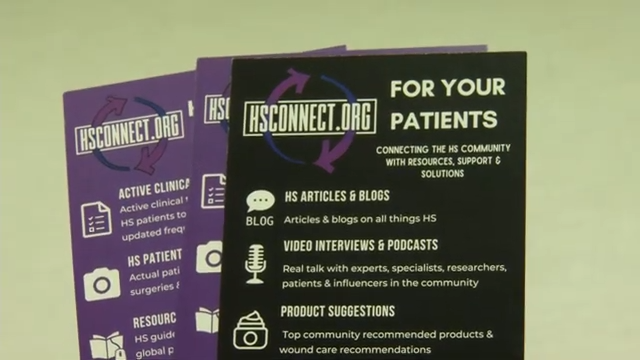MIAMI, Fla. (Ivanhoe Newswire) — When one man’s ring size went from a 10 to a 16, he didn’t know what to think. Turns out he suffers from the same condition that afflicted the famous wrestler, Andre the Giant. Find out what causes Acromegaly and what doctors are doing to treat it.
Creating custom furniture is a problem-solving process. But when Anthony Bucher’s health began to decline, it was a problem he couldn’t solve on his own.
Anthony shared, “My hands and feet started growing over time. I would look at my face and wonder why my jaw was pushing out and my cheekbones were growing.”
Years went by before Anthony was diagnosed with Acromegaly.
Atil Kargi, MD, University of Miami Miller School of Medicine, said, “Patients with this disorder typically present with changes in their hands and their feet as well as in their facial features.”
Dr. Kargi says the condition is caused by an excess of growth hormone.
“It’s almost always due to a pituitary tumor that’s secreting high levels of growth hormone affecting all parts of the body,” continued Dr. Kargi.
Symptoms may also include headaches, sweating, fatigue and hypertension.
“Patients with Acromegaly, if left untreated, have a life-expectancy that’s about ten years shorter than average,” explained Dr. Kargi.
The good news is if caught early doctors can remove the tumor.
“A neurosurgeon will actually go through the nose and right underneath the brain, remove the pituitary tumor,” Dr. Kargi said.
From 50 to 90 percent of patients are cured of symptoms.
Anthony’s tumor could only be partially removed. So he also underwent radiation.
“Radiation actually takes three to five years to take effect,” shared Anthony.
It’s a long, slow process … not a sprint. As his pet tortoise “Chompers” reminds him every day.
Anthony gives himself a daily shot to reduce his growth hormone. But he says the medication is costly: up to $20,000 dollars a month! Insurance and a grant from Pfizer is helping him cover most of the cost. Children can also suffer from this condition, although rare. For more information on clinical trials for Acromegaly and other pituitary problems please visit: http://umbti.med.miami.edu/programsUPit
Contributors to this news report include: Janna Ross, Field Producer; Roque Correa, Editor; and Judy Reich, Videographer.
Free weekly e-mail on Medical Breakthroughs from Ivanhoe. To sign up: http://www.ivanhoe.com/ftk
ACROMEGALY: A GROWING PROBLEM
REPORT #2622
BACKGROUND: Acromegaly is a rare endocrine disorder where too much growth hormone (GH) is produced by the pituitary gland. In most cases, the excess GH comes from benign adenomas on the pituitary. Acromegaly is most often diagnosed in middle-aged adults, although symptoms can appear at any age. When GH-producing tumors occur in childhood, it is referred to as gigantism rather than acromegaly. Some adenomas grow slowly and symptoms may not be noticed for many years. Other adenomas grow more rapidly and invade surrounding brain areas or the venous sinuses. Most pituitary tumors develop spontaneously and are not genetically inherited. An estimated 60 out of every million people have acromegaly. However, it is believed that many persons with acromegaly go undiagnosed. If it’s not treated promptly, acromegaly can lead to serious illness and may even become life-threatening. However, available treatments can reduce your risk of complications and significantly improve characteristics of the condition, including the enlargement of your features.
(Source: https://www.raredr.com/news/acromegaly-rare-disease-quick-facts/ and https://www.mayoclinic.org/diseases-conditions/acromegaly/symptoms-causes/syc-20351222)
SYMPTOMS AND TREATMENT: A common sign of acromegaly is enlarged hands and feet. People with this disorder often notice they aren’t able to put on rings that used to fit and their shoe size has progressively increased. Acromegaly may also cause gradual changes in the shape of your face, such as a protruding lower jaw and brow, an enlarged nose, thickened lips, and wider spacing between your teeth. Because acromegaly tends to progress slowly, early signs may not be obvious for years. Acromegaly may also produce some of the following signs and symptoms: coarse, oily, thickened skin; excessive sweating and body odor; small outgrowths of skin tissue (skin tags); fatigue and muscle weakness; impaired vision; headaches; enlarged tongue; and pain and limited joint mobility. Treatment focuses on lowering your production of GH, as well as reducing the negative effects of the tumor on the pituitary gland and surrounding tissues. Doctors can remove most pituitary tumors using a method called, transsphenoidal surgery. In this procedure, the surgeon works through your nose to extract the pituitary tumor. Drugs and oral medications can be used to lower the production or block the action of GH. Finally, your doctor may recommend radiation treatment if tumor cells remain after surgery.
(Source: https://www.mayoclinic.org/diseases-conditions/acromegaly/symptoms-causes/syc-20351222 and https://www.mayoclinic.org/diseases-conditions/acromegaly/diagnosis-treatment/drc-20351226)
MODERN TREATMENT FOR ACROMEGALY: Gamma knife radiosurgery (GKS) is a modern form of radiotherapy. It is delivered in a single session from a cobalt-60 source by focused radiation with little radiation to the surrounding brain tissue, both advantages compared with conventional radiotherapy. It is especially useful for tumors invading the cavernous sinuses where the cranial nerves are much less susceptible to damage from radiation than the optic nerves. In one study, 68 patients treated by GKS (most of whom as primary treatment), were followed up for 6 to 52 months. Normalization of growth hormone was achieved in 40% of patients followed up for 12 months and 96% of patients followed up for more than 24 months. The tumor size shrank in 52% and 87% of cases respectively. In another study comparing GKS with conventional fractionated radiotherapy in patients who had unsuccessful surgery in the past, the mean time for simultaneous normalization of growth hormone was 1.4 years for the GKS group compared with 7.1 years for the fractionated radiotherapy group. Longer follow up studies are needed to assess the long-term efficacy and adverse effects of GKS.
(Source: https://pmj.bmj.com/content/79/930/189)
* For More Information, Contact:
Atil Y. Kargi, MD / UM Miller School of Medicine Kai Hill, PR UM Miller School of Medicine
akargi@med.miami.edu / (305) 243-3636 khill@med.miami.edu / (305) 243-3249



